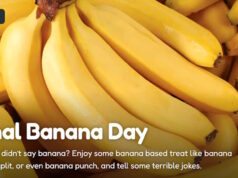
Each year on November 28th, people across the United States enjoy National French Toast Day. Also known as eggy bread, omelet bread or gypsy toast, it makes a great breakfast for guests or part of a brunch.
- The breakfast favorite French toast goes by many names depending on where it’s being served up – eggy bread, German toast, poor knights’ pudding, Bombay toast – but it’s always made of the same key ingredients.
- In France, its name is ‘pain perdu’, which literally means ‘lost bread’, because it would often be made with stale or old bread.
- Some ancient Latin recipes from the 4th-century mention soaking bread in milk before frying, and in fourteenth Century Germany the term ‘poor knights’ pudding’ was coined for the sweet treat because it was seen as an affordable meal for those without too much money to spend.
- In Italy, there’s a savory version, called ‘mozzarella en carrozza’, which sees the egg-soaked bread sandwiching slices of mozzarella cheese before it is fried. Its name literally means ‘mozzarella in a carriage’.
- French toast was not invented in France. In fact, French toast was around long before France even existed as a country.
- The earliest reference to French toast dates all the way back to 4th century Rome.
- The name for French toast in France is “pain perdu”, which means “lost bread.”
- One of the original French names for this dish is le pain á la Romaine, or Roman bread.
- It was not until the 17th century that the term “French Toast” appeared in England (in 1660, to be precise, in a book called The Accomplisht Cook, according to The Oxford English Dictionary). This would be in line with one of the theories developed about French fries which is that the name “French” does not designate from the country of origin of the dish, but is instead in reference to the verb “to French” which means “to slice” in Old Irish. Hence, “French toast” as in “sliced toast.”
- French toast was created by medieval European cooks who needed to use every bit of food they could find to feed their families. They knew day-old bread could be revived when moistened and heated. They also added eggs for additional moisture and protein.
- In Scotland, French toast is traditionally served with sausage between two slices of French toast, eaten as a sandwich.
- Medieval recipes for French toast suggest this meal was enjoyed by the wealthy.
- The phrase “French toast” first appeared in print in the Encyclopedia of American Food and Drink in 1871.
- The earliest known reference to French toast is in the Apicius, a collection of Latin recipes dating to the 4th or 5th century, where it is described as simply aliter dulcia (“another sweet dish”). The recipe says to “slice fine white bread, remove the crust, and break it into large pieces. Soak these pieces in milk and beaten egg, fry in oil, and cover with honey before serving.
- In India, French toast is made without sweeteners, typically being made with egg, milk, salt, green chili, and chopped onions and generally served with ketchup.
- Hong Kong-style French toast is typically prepared by combining multiple slices of bread with peanut butter or fruit jam filling, then dipping in beaten egg and deep frying. It is served with butter and topped with golden syrup or honey.
- The people of New Zealand prefer their French toast served with bananas, bacon, and maple syrup.
- Torrija is a similar recipe traditionally prepared in Spain for Lent and Holy Week. It is usually made by soaking stale bread in milk or wine with honey and spices. It is dipped in beaten egg and fried with olive oil.
Sources:












